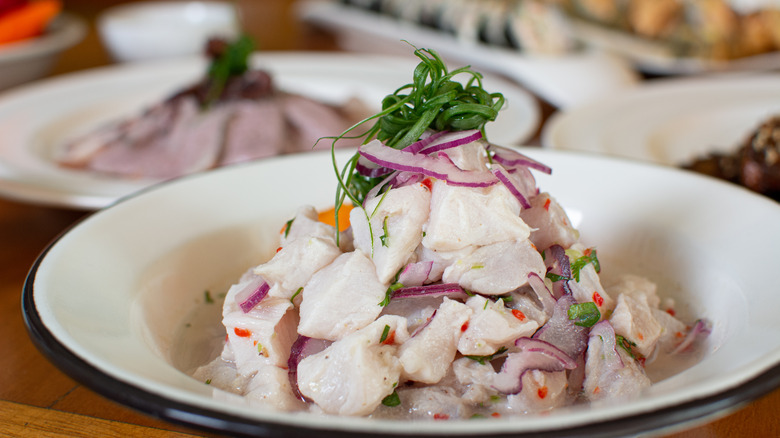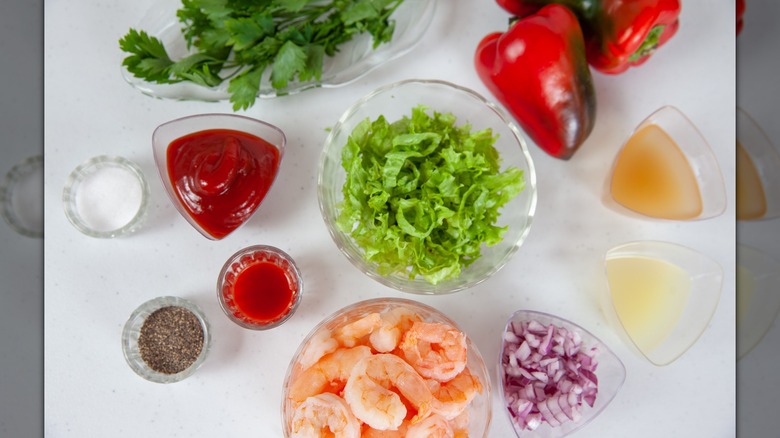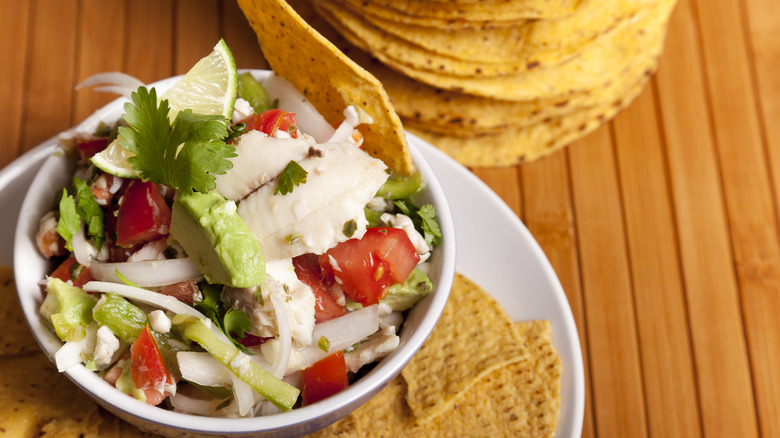What Is Ceviche And Is It Actually Raw?
If you've had the opportunity to travel to Central and South America, you've likely also had the chance to try ceviche. To make ceviche (which is the national dish of Peru), pieces of cubed or sliced fish are marinated and "cooked" in an acidic solution — most commonly lime, lemon, or orange juice mixed with fresh piquant veg. The result is fish that is opaque and firm on the outside, and tender and more-or-less raw (or crudo) on the inside. The flavor is wonderfully fresh and zesty and predominantly like uncooked fish — and that's because it still is.
In a flavorful chemical reaction that occurs during marination, the fish's proteins become denatured — just as they are when subjected to heat. And because marine proteins tend to be lighter and more tender than terrestrial ones, they are more sensitive to these methods. Most fish species finish cooking around 20 degrees less than red meats, and that's why a citrus bath is enough to put some color on these raw cubes.
It's worth noting that since the fish is briefly marinated and not actually cooked, harmful pathogens and food bacteria could be present. So, for safety's sake, when making ceviche, it's best to use the highest quality, fish available, just as you would when making other raw fish dishes like sushi.
How to make ceviche
While you can find flavorful varieties of ceviche when traveling in Latin American countries like Mexico, fortunately, you can also make the dish at home. When throwing together your own flavorful and colorful dish of ceviche, choose an ocean fish variety like snapper, seabass, mahi mahi, or halibut. Seafood like shrimp, scallops, or octopus are also excellent and widely featured in ceviche. Whatever fish you decide on, just make sure it's high quality, fresh, and made to eat soon after bringing it home.
Cut the fish into relatively small bite-sized pieces, then marinate it in a bowl in the fridge with an ample amount of citrus juice — enough to completely submerge and coat all pieces. The marinade time is quick – about 15 to 20 minutes to achieve the perfect texture. Though some cooks let their ceviche marinate for hours (and it may be tempting to let the fish marinate longer as you would with meat), extending the marinating time much past 20 or 30 minutes has proven to lead to dried-out fish that falls apart too easily.
Mix your ceviche up with other ingredients to complement the flavor of the fish and citrus, including finely diced red onions, jalapenos, cilantro, and spices. Once the fish has marinated in the citrus, drain it, so it doesn't continue to "cook" and soften — that is, unless, you'll eat it all right away (which is encouraged).
Different variations on the raw fish dish
The beauty of ceviche is its citrusy freshness — and for this reason, the dish pairs perfectly with simple ingredients. Most commonly, it's enjoyed with tortilla chips, spooned onto tostadas, or even eaten as-is. Aside from the type of fish you use, depending on your personal preferences, you can customize your marinade and the ingredients you toss with the fish. Add a bit of cayenne, smoked paprika, or red pepper flakes to your marinade for some subtle heat — just be careful it doesn't overpower it. Toss your ceviche with fresh cilantro, tomatoes, chiles, and diced avocado to serve it traditionally.
If you're in the mood to experiment, add a bit of sugar and see if you like the added sweetness. Some chefs even add a bit of ketchup to the mix. On that note, if acidic tomato flavors are your jam, you could marinate the fish in a thin tomato sauce (similar to the way it's served in Ecuador), or toss it in coconut milk or other zesty dressings. Whatever variations you choose, you'll want to go for a fine balance of flavors that really showcase the star flavor of the dish: which, yes, is fresh, raw fish.


